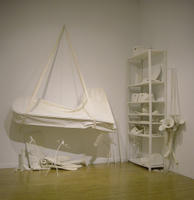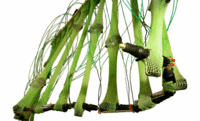Tuesday, July 12, 2005
A Different Sort of Summer Group Show
It’s become a seasonal event—the flocking of dealers and collectors to Columbia and Hunter open studios and MFA exhibitions. With all those birds migrating elsewhere this weekend, anyone staying in the city has the opportunity for a peaceful, quiet viewing of an exceptionally strong group show.
The Bronx Museum isn’t usually thought of as prime hunting ground for emerging talent, but it should be. Its annual Artist in the Marketplace (AIM) exhibition features notable work by a talented group of young artists, most of whom don’t yet have gallery representation.
This year’s exhibition, AIM 25, has no overarching theme, and there’s no curatorial vision imposed on the works included. The show simply presents pieces (ranging from the very strong to the moderately interesting) from this year’s program participants. The show includes work in diverse media—from painting to video to drawing to performance. Some of the most interesting work, though, is sculptural.
 Olen Hsu’s installation, Anacoluthon (installation view at right), raises more questions than it answers. Made of paper, latex, and twine, this soft sculpture of withering objects used for making music (a piano, music stands) emits a soft, pleasing algorithmically composed melody that draws viewers into the work’s presence and provides a soundtrack for their exploration of the piece’s surface and forms.
Olen Hsu’s installation, Anacoluthon (installation view at right), raises more questions than it answers. Made of paper, latex, and twine, this soft sculpture of withering objects used for making music (a piano, music stands) emits a soft, pleasing algorithmically composed melody that draws viewers into the work’s presence and provides a soundtrack for their exploration of the piece’s surface and forms.
Installed nearby, Tom Kotik’s Brown (Maximum Volume) also uses sound to hook viewers, but in Kotik’s case the sound made by the work is inaudible. The piece—an amplifier connected to an exposed speaker which pulses slowly and regularly—plays a tone so low as to be outside the range of human hearing. Expecting to hear something interesting emerging from this simply presented, out-of-date audio technology, viewers instead are transfixed by the disturbing pulsing of the woofer, becoming mesmerized by the strange soundless motion it makes.
 Meridith Pingree’s kinetic sculpture, Worm Decay (at left), also commands interest as it pulses, wiggles, and jerks in response to movement in its environment. Across the gallery, Beth Gilfilen’s quiet and still three-dimensional installation of cut and drawn-upon commercial paint chips sits firmly within the body of work emerging in recent years that will be seen by future art historians as having meaningfully expanded the possibilities for the medium of drawing.
Meridith Pingree’s kinetic sculpture, Worm Decay (at left), also commands interest as it pulses, wiggles, and jerks in response to movement in its environment. Across the gallery, Beth Gilfilen’s quiet and still three-dimensional installation of cut and drawn-upon commercial paint chips sits firmly within the body of work emerging in recent years that will be seen by future art historians as having meaningfully expanded the possibilities for the medium of drawing.
This is not to say that only the sculptural works in the show are of interest. Vlatka Horvat’s four photographs from her Searching series present a young woman—head stuck into a bush, under a car, and in other strange places—obviously searching for something. But what? The ambiguity of the poses and the implied narrative delight. Thessia Machado includes a wonderful two-minute-long soundless digital video that focuses on a woman’s navel. Her belly is covered with small moles which she flicks with her finger. When each is touched it spirals down into the vortex of her belly button and disappears into the folds of skin. Equally as quirky and engaging as Horvat’s photographs, this piece is a small humorous gem.
Rather than turning it into a hodgepodge of recent work, the lack of curator-imposed homogeneity in this show is refreshing. It’s the summer group show that is an antidote to what’s currently on display around Chelsea. If gallerists from that neighborhood would be willing to make the train trip up to the Bronx (note to galleristas: it doesn’t take as long to get there as it does to get to the Hamptons), they'll be sure to find much of interest for their fall and spring seasons.
AIM 25 is on display at the Bronx Museum of the Arts through October 2, 2005.
The Bronx Museum isn’t usually thought of as prime hunting ground for emerging talent, but it should be. Its annual Artist in the Marketplace (AIM) exhibition features notable work by a talented group of young artists, most of whom don’t yet have gallery representation.
This year’s exhibition, AIM 25, has no overarching theme, and there’s no curatorial vision imposed on the works included. The show simply presents pieces (ranging from the very strong to the moderately interesting) from this year’s program participants. The show includes work in diverse media—from painting to video to drawing to performance. Some of the most interesting work, though, is sculptural.
 Olen Hsu’s installation, Anacoluthon (installation view at right), raises more questions than it answers. Made of paper, latex, and twine, this soft sculpture of withering objects used for making music (a piano, music stands) emits a soft, pleasing algorithmically composed melody that draws viewers into the work’s presence and provides a soundtrack for their exploration of the piece’s surface and forms.
Olen Hsu’s installation, Anacoluthon (installation view at right), raises more questions than it answers. Made of paper, latex, and twine, this soft sculpture of withering objects used for making music (a piano, music stands) emits a soft, pleasing algorithmically composed melody that draws viewers into the work’s presence and provides a soundtrack for their exploration of the piece’s surface and forms.Installed nearby, Tom Kotik’s Brown (Maximum Volume) also uses sound to hook viewers, but in Kotik’s case the sound made by the work is inaudible. The piece—an amplifier connected to an exposed speaker which pulses slowly and regularly—plays a tone so low as to be outside the range of human hearing. Expecting to hear something interesting emerging from this simply presented, out-of-date audio technology, viewers instead are transfixed by the disturbing pulsing of the woofer, becoming mesmerized by the strange soundless motion it makes.
 Meridith Pingree’s kinetic sculpture, Worm Decay (at left), also commands interest as it pulses, wiggles, and jerks in response to movement in its environment. Across the gallery, Beth Gilfilen’s quiet and still three-dimensional installation of cut and drawn-upon commercial paint chips sits firmly within the body of work emerging in recent years that will be seen by future art historians as having meaningfully expanded the possibilities for the medium of drawing.
Meridith Pingree’s kinetic sculpture, Worm Decay (at left), also commands interest as it pulses, wiggles, and jerks in response to movement in its environment. Across the gallery, Beth Gilfilen’s quiet and still three-dimensional installation of cut and drawn-upon commercial paint chips sits firmly within the body of work emerging in recent years that will be seen by future art historians as having meaningfully expanded the possibilities for the medium of drawing.This is not to say that only the sculptural works in the show are of interest. Vlatka Horvat’s four photographs from her Searching series present a young woman—head stuck into a bush, under a car, and in other strange places—obviously searching for something. But what? The ambiguity of the poses and the implied narrative delight. Thessia Machado includes a wonderful two-minute-long soundless digital video that focuses on a woman’s navel. Her belly is covered with small moles which she flicks with her finger. When each is touched it spirals down into the vortex of her belly button and disappears into the folds of skin. Equally as quirky and engaging as Horvat’s photographs, this piece is a small humorous gem.
Rather than turning it into a hodgepodge of recent work, the lack of curator-imposed homogeneity in this show is refreshing. It’s the summer group show that is an antidote to what’s currently on display around Chelsea. If gallerists from that neighborhood would be willing to make the train trip up to the Bronx (note to galleristas: it doesn’t take as long to get there as it does to get to the Hamptons), they'll be sure to find much of interest for their fall and spring seasons.
AIM 25 is on display at the Bronx Museum of the Arts through October 2, 2005.